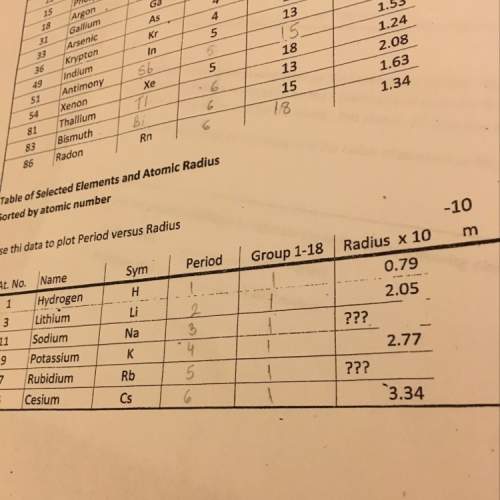
Alana is a scientist studying nuclear reactions. She has just published a paper explaining a new scientific theory about the atomic nucleus. What is most likely true about the theory? A. The theory is not yet supported by any experimental or observational evidence. B. Once the theory has been tested, it will be reclassified as a scientific law. C. Several other scientists read Alana's paper about the theory before it was published. D. There is a scientific consensus, and most scientists agree that the theory is correct.

Answers: 2
Other questions on the subject: Chemistry

Chemistry, 22.06.2019 05:30, NorbxrtThaG
The table describes how some substances were formed substance 19 description formed by boiling pure water formed by combining three hydrogen atoms to every nitrogen atom formed by adding 5 g of sugar to 1 l of water formed by compressing carbon under high pressure based on the given descriptions, which substance is most likely a mixture?
Answers: 1

Chemistry, 22.06.2019 12:30, skaterwolf1317
Which statement is true about this reaction? 14n+1h 15o it is a practical source of energy on earth. it occurs only outside the solar system. its product is heavier than each of its reactants. it shows the critical mass of an element.
Answers: 2

Chemistry, 22.06.2019 18:30, bibiansolis
The table lists the lattice energies of some compounds. compoundlattice energy (kj/mol)lif –1,036licl –853naf –923kf –821nacl –786which statement about crystal lattice energy is best supported by the information in the table? the lattice energy increases as cations get smaller, as shown by lif and kf. the lattice energy increases as the cations get larger, as shown by lif and licl. the lattice energy decreases as cations get smaller, as shown by nacl and naf. the lattice energy decreases as the cations get smaller, as shown by naf and kf.
Answers: 3

Chemistry, 23.06.2019 03:30, memester74
Scientists often deal with numbers that are either very large or very small. for example, the radius of the sun is approximately 696,000 kilometers, while bacterial cells are as small as 1.9 × 10-4 millimeters. express each of these numbers in an alternate form.
Answers: 3
Do you know the correct answer?
Alana is a scientist studying nuclear reactions. She has just published a paper explaining a new sci...
Questions in other subjects:

Biology, 20.09.2019 10:10

Biology, 20.09.2019 10:10

History, 20.09.2019 10:10



Mathematics, 20.09.2019 10:10


Arts, 20.09.2019 10:10


Mathematics, 20.09.2019 10:10







